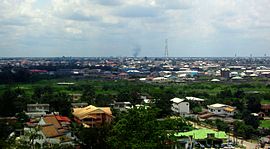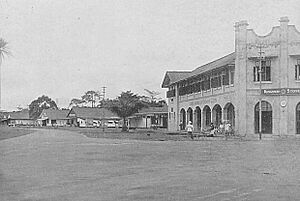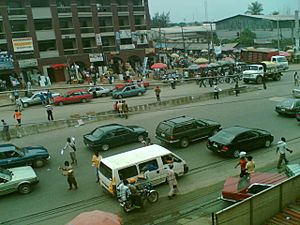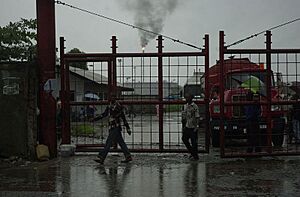Port Harcourt facts for kids
Quick facts for kids
Port Harcourt
|
||
|---|---|---|
|
Metropolis
|
||

Port Harcourt
|
||
|
||
| Nickname(s):
PH-City, P.H. and Garden City
|
||
| Country | Nigeria | |
| State | Rivers | |
| LGA(s) | Port Harcourt Obio-Akpor Okrika Eleme |
|
| Founded | 1912 | |
| Incorporation | 1913 | |
| Named for | Lewis Vernon Harcourt | |
| Government | ||
| • Type | Mayor–Council | |
| • Body | Port Harcourt City Council | |
| Area | ||
| • Metropolis | 369 km2 (142 sq mi) | |
| • Land | 360 km2 (140 sq mi) | |
| • Water | 9 km2 (3 sq mi) | |
| • Urban | 158 km2 (61 sq mi) | |
| • Metro | 1,900 km2 (700 sq mi) | |
| Population
(2006 census)
|
||
| • Metropolis | 1,005,904 | |
| • Estimate
(2019)
|
1,148,665 | |
| • Density | 2,726/km2 (7,060/sq mi) | |
| • Urban | 1,865,000 | |
| • Urban density | 11,800/km2 (30,570/sq mi) | |
| • Metro | 2,344,000. | |
| • Metro density | 1,230/km2 (3,200/sq mi) | |
| Demonym(s) | Portians | |
| GDP (PPP, constant 2015 values) | ||
| • Year | 2023 | |
| • Total | $34.4 billion | |
| • Per capita | $9,900 | |
| Time zone | UTC+1 (WAT) | |
| Postcode |
500
|
|
| Area code(s) | 084 | |
| Climate | Am | |
Port Harcourt is a large and important city in Nigeria. It is the capital of Rivers State. People sometimes call it Po-ta-kot or Pi-ta-kwa in Nigerian Pidgin. It is also known as "PH-City" or the "Garden City".
Port Harcourt is located along the Bonny River. It is in the Niger Delta region, which is famous for its oil. In 2023, about 3.48 million people lived in the city. The larger metropolitan area had about 2.34 million people in 2015. The city has grown a lot since 1950, when its population was around 60,000.
Before 1912, the area was farmland belonging to the Rebisi people. The British colonial government created the port. Its main purpose was to export coal from Enugu, which was connected by a railway.
The city's economy changed when oil was discovered in Nigeria. The first Nigerian crude oil was shipped from Port Harcourt in 1958. This helped the city grow and become more modern. Many oil companies, like Shell and Chevron, have offices here.
Port Harcourt has many schools and universities. The main airport is Port Harcourt International Airport. The current mayor is Allwell Ihunda.
Contents
- What's in a Name?
- A Look Back: Port Harcourt's History
- Port Harcourt's Location and Climate
- Environmental Concerns in Port Harcourt
- Where People Live: Residential Areas
- Port Harcourt's Economy
- People and Cultures
- Culture and Entertainment
- Learning and Education
- Media and Communication
- Getting Around: Transport
- Sports and Recreation
- Staying Healthy: Healthcare
- Water Supply and Cleanliness
- Future Plans: Greater Port Harcourt
- Images for kids
- Famous People from Port Harcourt
- Sister Cities
- See also
What's in a Name?
The port was built in 1912. It got its name in August 1913. The Governor of Nigeria, Sir Frederick Lugard, named it "Port Harcourt". This was to honor Lewis Harcourt, 1st Viscount Harcourt, who was a British government official.
The local Okrika people call the city Hakoti Kiri or Parakot. The Obulom people call it Obomotu, which means "Big House".
A Look Back: Port Harcourt's History
Port Harcourt was founded in 1912 by Frederick Lugard. He was the governor of both the Northern and Southern Nigeria Protectorates. The city was built to help export coal found in Enugu.
The colonial government took land from the people of Diobu to build the port-town. Other villages like Oroworukwo and Nkpogu were later included. Fishing communities of the Wakirike-Ijaw group were also in the area.
During World War I, Port Harcourt was a base for military actions. These actions were against German forces in Kamerun. In 1956, crude oil was found in Oloibiri. Port Harcourt then shipped Nigeria's first oil in 1958.
The city became the center of Nigeria's oil industry. It grew quickly with new buildings and modern features. Port Harcourt also became a major commercial and industrial hub for the Eastern Region. During the Nigerian Civil War, the city fell to Nigerian forces in 1968. The city expanded from about 15.54 square kilometers in 1914 to 360 square kilometers by the 1980s.
Port Harcourt's Location and Climate

The main part of Port Harcourt is in the Port Harcourt local government area. This includes areas like Old GRA and New Layout. The larger urban area, called Port Harcourt metropolis, also includes parts of Obio-Akpor and Eleme.
Port Harcourt is the only big city in Rivers State. This means it can get very crowded. In 2009, a law was passed to help spread development to nearby communities. This helps to reduce crowding in the city center.
The Greater Port Harcourt region is much larger. It covers eight local government areas. These include Port Harcourt, Okrika, Obio-Akpor, Ikwerre, Oyigbo, Ogu–Bolo, Etche and Eleme. In 2009, its population was estimated at 2 million. This makes it one of Nigeria's largest metropolitan areas.
Weather in Port Harcourt
Port Harcourt has a tropical monsoon climate. This means it has long, heavy rainy seasons. It also has very short dry seasons. The months from December to February are the driest.
The harmattan wind, which affects many West African cities, is not as strong here. September usually gets the most rain, with about 367 millimeters (14.4 inches). December is the driest month, with only about 20 millimeters (0.8 inches) of rain.
Temperatures in Port Harcourt stay fairly steady all year. They are usually between 25 and 28 degrees Celsius (77 and 82 degrees Fahrenheit). The average yearly temperature is about 26.55 degrees Celsius (79.79 degrees Fahrenheit). The city gets about 330.36 millimeters (13.01 inches) of rain each year. It rains on about 305 days a year.
| Climate data for Port Harcourt (1991–2020) | |||||||||||||
|---|---|---|---|---|---|---|---|---|---|---|---|---|---|
| Month | Jan | Feb | Mar | Apr | May | Jun | Jul | Aug | Sep | Oct | Nov | Dec | Year |
| Record high °C (°F) | 37 (99) |
38.5 (101.3) |
38 (100) |
36.2 (97.2) |
37.2 (99.0) |
34 (93) |
32.5 (90.5) |
33 (91) |
33.1 (91.6) |
39 (102) |
35.2 (95.4) |
36 (97) |
39.0 (102.2) |
| Mean daily maximum °C (°F) | 33.1 (91.6) |
34.0 (93.2) |
33.2 (91.8) |
32.6 (90.7) |
31.9 (89.4) |
30.2 (86.4) |
29.0 (84.2) |
28.9 (84.0) |
29.6 (85.3) |
30.5 (86.9) |
31.8 (89.2) |
32.7 (90.9) |
31.5 (88.7) |
| Daily mean °C (°F) | 27.2 (81.0) |
28.4 (83.1) |
28.4 (83.1) |
28.0 (82.4) |
27.6 (81.7) |
26.6 (79.9) |
25.9 (78.6) |
25.8 (78.4) |
26.2 (79.2) |
26.7 (80.1) |
27.3 (81.1) |
27.2 (81.0) |
27.1 (80.8) |
| Mean daily minimum °C (°F) | 21.3 (70.3) |
22.8 (73.0) |
23.5 (74.3) |
23.5 (74.3) |
23.3 (73.9) |
22.9 (73.2) |
22.7 (72.9) |
22.8 (73.0) |
22.9 (73.2) |
22.8 (73.0) |
22.9 (73.2) |
21.8 (71.2) |
22.8 (73.0) |
| Record low °C (°F) | 11.6 (52.9) |
16.7 (62.1) |
16 (61) |
15.9 (60.6) |
16.4 (61.5) |
19 (66) |
19 (66) |
19.6 (67.3) |
12.5 (54.5) |
19.5 (67.1) |
18 (64) |
15 (59) |
11.6 (52.9) |
| Average precipitation mm (inches) | 22.1 (0.87) |
59.7 (2.35) |
114.6 (4.51) |
159.2 (6.27) |
260.9 (10.27) |
310.1 (12.21) |
357.9 (14.09) |
290.2 (11.43) |
354.0 (13.94) |
251.7 (9.91) |
87.2 (3.43) |
19.0 (0.75) |
2,286.5 (90.02) |
| Average precipitation days (≥ 1.0 mm) | 1.8 | 3.6 | 8.0 | 10.0 | 14.2 | 16.6 | 19.2 | 19.2 | 19.0 | 16.0 | 6.9 | 1.4 | 135.9 |
| Average relative humidity (%) | 78.1 | 81.7 | 87.3 | 89.1 | 90.0 | 91.0 | 91.1 | 90.7 | 91.4 | 90.9 | 88.1 | 80.7 | 87.5 |
| Mean monthly sunshine hours | 142.6 | 123.2 | 114.7 | 132.0 | 139.5 | 102.0 | 77.5 | 74.4 | 78.0 | 102.3 | 132.0 | 148.8 | 1,367 |
| Source: NOAA (sunshine 1961–1990) | |||||||||||||
Environmental Concerns in Port Harcourt
Since late 2016, people in Port Harcourt have noticed a lot of particle pollution. This is often called "soot." Their clothes and outdoor surfaces get covered in a layer of black soot.
Official reports in 2016 showed high levels of tiny particles (PM2.5) in the air. These levels were 270 micrograms per cubic meter. The U.S. Environmental Protection Agency (EPA) says that levels between 200 and 300 are unhealthy for everyone. They suggest avoiding heavy outdoor activities.
For 15 months ending in June 2018, the air quality was unhealthy for 240 days. It was very unhealthy for 85 days and even dangerous for 13 days. This bad air quality led to protests in February 2017. Soot was found everywhere: in noses, on cars, floors, and even in drinking water.
Some areas like Abuloma and Okrika were hit hardest. People in places like Rumosi even moved to safer cities. This caused some businesses to slow down.
The Ministry of Environment took action. They tested air samples and found pollution levels 11 times higher than WHO standards. They closed down some companies that were releasing a lot of pollution. Other suspected sources of soot include illegal oil refineries, burning tires, and gas flaring.
Where People Live: Residential Areas
Port Harcourt has many well-known neighborhoods. Some of these include Port Harcourt Township, GRA (Government Reserved Area) phases 1–5, Elekahia, and Rumuomasi. Other popular areas are D-line, Elelenwo, and Diobu.
The main industrial area is in Trans Amadi, Abuloma. The Point Block of Rivers State Secretariat is a famous building. It is an 18-story building and the tallest in its region.
Port Harcourt's Economy
Port Harcourt is a major industrial hub. Many large international companies operate here. A lot of businesses are connected to the petroleum industry.
The city is Nigeria's main oil-refining center. It has two large oil refineries in Eleme. These refineries process about 210,000 barrels of crude oil every day. The Port Harcourt Refining Company operates both.
Rivers State is one of Nigeria's richest states. This is because of its oil industry. Crude oil is the state's main export.
People and Cultures
Who Lives in Port Harcourt?
Port Harcourt is home to several groups of people. The main groups are the coastal Ikwerre, Ijaw, Obulom, and Ogoni peoples.
Faith and Religion
Like other cities in southern Nigeria, most people in Port Harcourt are Christian. A large number of Christians are Roman Catholics. The city has many churches and priests. The main Catholic church is the Corpus Christi Cathedral.
Other Christian groups also live here. These include Anglicans, Methodists, Baptists, and Presbyterians. There are also Jehovah's Witnesses and members of Evangelical and Pentecostal churches. A small number of people in the city follow the Islamic faith.
Culture and Entertainment
Books and Festivals
The Port Harcourt Book Festival is a very important event. It started in 2008 and is held every year. The festival helps people in the city read more. It also helps publishers and writers reach a bigger audience.
Famous publishers like Heinemann have attended the festival. Writers and book lovers from all over come to Port Harcourt for this event. In 2012, UNESCO named Port Harcourt the World Book Capital for 2014. It was the first city in Black Africa to receive this honor.
Nightlife and Fun
Port Harcourt is known for its lively evening activities. There are many public houses, lounges, clubs, and restaurants. People who like to party often go to New GRA. This area has most of the high-end bars and nightclubs. You can hear upbeat music almost everywhere in the city at night.
Learning and Education
Universities and Colleges
Port Harcourt has many higher education institutions. They offer a variety of programs and degrees. Most of these schools get money from the government. Some are run by private groups.
The University of Port Harcourt is a well-known federal university. In 2015, it was ranked sixth in Africa and first in Nigeria by Times Higher Education. Its main campus is in the Choba district.
The Government of Rivers State also runs several universities and colleges. These include Rivers State University and Captain Elechi Amadi Polytechnic. Ignatius Ajuru University of Education and Rivers State College of Health Science and Technology are also here. Private schools include the Catholic Institute of West Africa.
Schools for Younger Students
Port Harcourt also has many primary and secondary schools. These schools provide education for younger students.
Media and Communication
Media in Port Harcourt includes print, online blogs, social media, and broadcast. News and information reach people through radio, television, newspapers, and the internet. The government owns some media outlets, but private media is also allowed.
The Rivers State Ministry of Information and Communications oversees broadcasting. They make sure there is fair competition and good services. Most media content is in English. This is because English is widely spoken in Nigeria's cities.
Newspapers in the City
The most widely read daily newspaper in Port Harcourt is The Tide. It is supported by the state government and has an online version. Another popular newspaper is National Network. Other papers like The Neighbourhood and The Newswriter are also becoming popular.
Radio Stations
Radio is a very important way to get information. It is a strong source of news and entertainment. Radio also reaches many people and is an affordable way to share information. Most radio stations in Port Harcourt are privately owned.
Radio Rivers started in 1981. It offers programs in English and local languages. The Rivers State Broadcasting Corporation (RSBC) operates it. By 2013, more than five local FM stations were licensed. These included stations owned by large media companies.
Television Channels
- Rivers State Television – This is a government-owned TV station. It is on UHF channel 22 and started in 1985.
Getting Around: Transport
Port Harcourt has an international airport, the Port Harcourt International Airport. It is located outside the city. There is also a Nigerian Air Force (NAF) base. This base has another airport used by commercial airlines for local flights. The city also has two seaports: FOT Onne and Port Harcourt Wharf.
Sports and Recreation
The city has three main stadiums. These are the Sharks Stadium, the Yakubu Gowon Stadium in Elekahia, and Adokiye Amiesimaka Stadium in Omagwa.
Port Harcourt is home to Rivers United F.C., a popular soccer club. In 2019, the governor of Rivers State, Nyesom Wike, announced plans for a football academy. This academy would be in cooperation with the famous Spanish club, Real Madrid. It is called the Real Madrid Academy. The academy was officially opened 18 months later.
Staying Healthy: Healthcare
Port Harcourt is a leading center for medical services in Rivers State. Many hospitals and research facilities are located here. The University of Port Harcourt Teaching Hospital (UPTH) is a major hospital. It is on East West Road.
Government hospitals are very popular. They serve a large number of patients. One of the oldest is Braithwaite Memorial Specialist Hospital. It was founded in 1925. This hospital has 375 beds and offers many medical and surgical services.
Between 2009 and 2013, the Rivers State government opened two more hospitals. These were Kelsey Harrison Hospital and the Rivers State Dental and Maxillofacial Hospital. Some notable private hospitals include Meridian Hospital and Rehoboth Specialist Hospital.
Water Supply and Cleanliness
The Port Harcourt Water Supply and Sanitation Project aims to provide clean water. It serves the people of Port Harcourt and Obio-Akpor local government areas. This project is the first step in fixing the old water system. It also extends water services to new parts of the city.
The project will improve the Rumuola water stations. This will increase their capacity to 187,000 cubic meters per day. In 2009, Rivers State started reforms in its water sector. These included new laws and policies in 2012.
These laws created special organizations for water services. Key agencies include the Rural Water Supply and Sanitation Agency (RWSSA). The Port Harcourt Water Corporation (PHWC) was also created. It replaced the old Rivers State Water Board. Its job is to provide clean drinking water and wastewater treatment. The corporation officially started in September 2014.
Future Plans: Greater Port Harcourt
Under former Governor Chibuike Amaechi, plans were made for a new city. It would be called Greater Port-Harcourt City. This new city will be located near the Port-Harcourt International Airport.
The Greater Port Harcourt city development covers about 1900 square kilometers. It spans eight local governments in Rivers State. These include Ogu Bolo, Eleme, Ikwerre, Etche, Obio Akpor, and Okrika.
The Authority (GPHCDA) was set up in April 2009. Its job is to help build the new city. The Authority is led by Dame Aleruchi Cookey Gam. The Greater Port Harcourt city hosted many events for the 17th national sports festival, known as "Garden City Games."
Images for kids
Famous People from Port Harcourt
Sister Cities
Port Harcourt has a special connection with another city. This is called a "sister city" relationship.
 Kansas City, Missouri, United States
Kansas City, Missouri, United States
See also
 In Spanish: Port Harcourt para niños
In Spanish: Port Harcourt para niños






















